As technology advances, it is natural for smartphones to experience some slowdown over time. Particularly for iPhones, several factors could affect their speed and performance. This article will guide you through various tips and techniques to help you get your iPhone back to its optimal performance. Solutions range from simple methods like clearing cache to more significant steps such as resetting your device. Let’s explore these strategies and understand how you can enhance the speed and efficiency of your iPhone without the need to invest in a new device right away.
Understanding and Managing “Other” Storage
One of the most overlooked aspects of iPhone maintenance is managing the “Other” storage category. This section is a storage catch-all where system files, caching data from apps, and even items like Siri voices are stored. The “Other” storage can be a significant memory hog due to the accumulated cache from various apps and web browsing activities. To check how much space this category is consuming on your device, navigate to Settings, then General, and finally iPhone Storage. Here, a bar graph will reveal the space taken by different categories, with ‘Other’ usually marked in gray.
If your ‘Other’ storage is indeed taking up more space than it should, various steps can help manage and reduce it. One straightforward method is to clear the cache from apps like Safari. To do this, go to Settings, then Safari, and select Clear History and Website Data. This step will remove unnecessary cached data, helping to free up storage. Moreover, closing tabs can lighten the load on Safari, making it run more smoothly. You can set Safari to close tabs automatically after a day, a week, or a month, further enhancing your phone’s performance.
Offloading Unused Apps
Another effective way to improve your iPhone’s performance is by offloading unused apps. This feature, introduced in iOS 11, is particularly useful for apps that take up significant space but are seldom used. Offloading means the app is removed from the device while retaining its data, allowing for easy reinstallation without data loss. To offload an app, navigate to Settings, then select General, followed by iPhone Storage. Here, you will see a list of apps and the storage amount each consumes, aiding in the decision of which apps to offload.
To offload a specific app, tap on it and then select Offload App. This method helps free up significant space, particularly for heavy apps like Google Maps, which may not store much data but occupy a lot of storage. Automatically offloading apps you rarely use can lead to noticeable improvements in your device’s speed and efficiency. For those who seldom manually clean their storage, enabling this function ensures that space is consistently freed up, optimizing your device’s overall performance.
Managing Text Message Storage
Text messages, especially those containing photos, videos, or other multimedia, can accumulate over time and consume valuable storage space. By default, iPhones are set to save all text messages indefinitely, which could be unnecessary if you don’t need to keep every conversation. Changing this setting allows you to limit storage usage without losing essential messages. To adjust this, go to Settings, then Messages, scroll to Message History, and select Keep Messages. You can choose to retain messages for 30 days or one year instead of forever.
Upon making this change, your iPhone will prompt you to delete older messages, which can further free up storage space. This tweak is particularly useful for those who often communicate via text, as it ensures old and likely irrelevant messages aren’t unnecessarily hogging storage. Reducing the duration for storing texts can lead to a general improvement in your iPhone’s speed and performance, making it a simple yet effective optimization step.
Resetting Your iPhone
Resetting your iPhone can be a last resort to fix persistent performance issues that aren’t resolved through other methods. A factory reset will erase all data and settings from your device, returning it to its original state. Before proceeding, ensure you backup your data to avoid losing important information. To reset your iPhone, go to Settings, then General, and select Reset. Choose Erase All Content and Settings, and follow the prompts to complete the process. Restoring your iPhone to its original state can significantly improve its speed and performance, giving it a fresh start.

